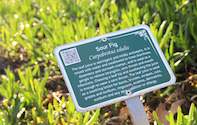Carpobrotus edulis is known as the humble sour fig, Cape fig, ghaukum, ghoenavy, Kaapse vy, perdevy, rankvy, suurvy, ikhambi-lamabulawo or umgongozi in Zulu.

This easy-growing ground cover is a useful medicinal plant with edible fruit and attractive yellow flowers that fade to pale pink. The sour fig can be found from the Namaqualand in the Northern Cape province all the way around the Western Cape coast to the Eastern Cape. The plant is an excellent dune stabiliser and fire resistant barrier.
Snakes are often found in clumps of sour figs to prey on rodents attracted to the fruit. Apart from rodents, the fruit are also enjoyed by antelope, porcupines and humans. The fruit ripens to a leathery wrinkled appearance with a mass of seeds in a jelly-like goo. The bottom of the fruit is bitten off and the mass of gel-like seeds are sucked out. The taste is rather astringent.
It is salty as well as sour and the fruit is used to make an excellent jam. To prepare the jam, cover 1 kg of sour figs with cold water (with 1 tsp salt). Soak overnight, drain and peel. Add two cups of sugar, a few sticks of cinnamon to one cup of water and boil until sticky. Then add sour figs - simmer till thick and the fruit is dark red in colour. Bottle in sterilised glass jars.
Sour figs leaves are bitter, antiseptic and can be chewed to relieve a sore throat, mouth infections, sunburn, itches, cold sores, nappy rash and blue bottle stings. Other medical uses include a cure for Tuberculosis (a syrup is made of the leave juice, olive oil and honey) and to treat constipation (by eating a syrup made from the fruit).
Sour fig is used in the Eastern Cape to treat diphtheria (a serious infection of the throat and nose) and diabetes. Sour fig grows easily from cuttings and enjoys well-drained soil and a sunny position.
Medical Disclaimer
Information is for educational and informational purposes only and may not be construed as medical advice. The information is not intended to replace medical advice or treatment offered by healthcare professionals.By Marinda Louw